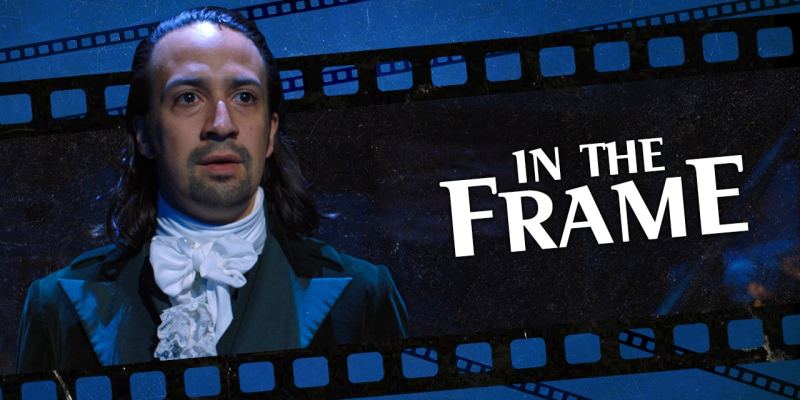There has been some debate about whether the version of Hamilton streaming on Disney+ could or should be classified as a movie in a traditional sense.
The release was recorded over a brief period in June 2016. It was edited together from a number of sources. The wide shots are recorded by nine cameras from two live performances (a Sunday matinee and a Tuesday evening show) at the Richard Rodgers Theatre. However, there are also close-ups that were recorded separately, with the camera crew moving on the stage between the carefully choreographed dancers.
There has been some debate about Oscar eligibility. Despite the precedent of Oscar nominations for actors like Laurence Olivier or James Whitmore for work in similar productions, and despite the Academy extending eligibility to streaming films that had originally planned a theatrical release, they have declared that Hamilton will not be eligible to compete at the Oscars next year. It can compete at the Emmys, and there are suggestions that Disney plans to submit it to individual guild awards.
It is apparent that Hamilton is not a traditional cinematic adaptation of a hit Broadway musical in the same way as The Sound of Music or Dreamgirls. There is no small irony in Hamilton being released early on streaming becoming one of the breakout hits of the summer, while the more traditional adaptation of Lin-Manuel Miranda’s other stage musical In the Heights has been pushed back. In some ways, the fact that one of the biggest blockbusters of 2020 isn’t really a movie is very 2020.

However, the difficulty in classifying Hamilton as a feature film is a large part of the release’s appeal. Hamilton is not packaging a narrative. After all, this release does not prevent a more conventional adaptation of the course material in the coming years. Instead, Hamilton is about packaging the experience of the musical. It is about trying to capture a snapshot of a particular cultural event, like lightning in a bottle.
There has been debate about whether Hamilton is dated, timely, or timeless. Like a lot of great pop cultural artifacts, it is all three simultaneously. It is undoubtedly an artifact of the Obama era, down to the fact that Miranda premiered material from the show at the White House in May 2009 and it became the center of one of the first controversies after Trump’s election. The musical frames its hero, the hard-working outsider fatherless policy wonk, as a mirror to the popular image of Obama.
However, there’s no denying that its reimagining of a more diverse American history (and even its assertion that “immigrants, [they] get the job done”) resonates strongly in the Trump era. New York Times critic-at-large Wesley Morris compared the bold remixing of American history – the stage is giant turntable – to the recent graffitiing of Confederate monuments in Richmond’s Monument Avenue. It feels appropriate that this version of the play exists simultaneously in 2016 and 2020.
This is the paradox of Hamilton. It boldly reimagines a more diverse history of America, while also erasing the more complicated aspects of the Founding Fathers in general and its protagonist in particular. It is a play that has through an unprecedented profit-sharing arrangement put a great deal of cash in the hands of its diverse cast, while appealing to a primarily rich white audience. It was the most exclusive (and expensive) ticket on Broadway, but it can now be watched in a living room.

In terms of the Disney+ release itself, what is most striking about it is the way that it makes no effort to disguise its theatricality. Thomas Kail has gone on to direct the television series Fosse/Verdon, but he is not a director with a strong cinematic sensibility. Describing guiding the camera through Hamilton’s staging, producer Dave Sirulnick noted that the camera operator had to be aware of “what’s happening around him,” ignoring the potential to just reshoot or reframe specifically for the camera.
To give Kail credit, Hamilton does benefit from some advantages of cinema. It has been argued that Aaron Burr is the dominant emotional perspective of the stage show, which makes sense when it is viewed from a forced wide angle shot that reflects Burr’s own viewpoint. However, the judicious use of close-ups benefits both Lin-Manuel Miranda as a performer and Alexander Hamilton as a character. The musical’s personal and emotional beats have a great intimacy on screen, the camera drawing the audience into the domestic drama as well as the wider political machinations.
At the same time, Hamilton is consciously built to emphasize that this is not a conventional feature film. Jonathan Groff’s in-character introduction as King George III opens the presentation, inviting the audience to turn off their phones and not to take photographs. Wide shots include silhouettes of the audience. The audience’s reactions are preserved, even over insert shots. The producers made a conscious choice to preserve the spit flying from Jonathan Groff’s mouth. There is even an interval.
The goal is to offer a facsimile of the theatrical experience on streaming, to present – within the boundaries of the medium – a sense of what it was like to have the best seats on Broadway in June 2016. Hamilton is a celebration of that experience. It makes sense that one of the more interesting arguments about the project’s awards eligibility was whether it might be considered a documentary. It is not so much a presentation of Hamilton as a presentation of a staging of Hamilton.

This exists as part of a larger trend in cinema. In the 1950s, threatened by television, cinema invested in experiences that audiences could not get on the small screen – gimmicks like 3D, formats like CinemaScope, epics with incredible budgets. In recent years, as streaming services like Netflix have shown that they can compete in terms of blockbusters and awards fare, traditional cinematic productions have made similar efforts to emphasize their own strengths.
As home media systems have gotten better and as budgets have grown, cinema has learned the core distinction between itself and streaming: Cinema is a communal medium. Streaming is typically intimate: Small groups gather around a screen, or a person streaming on public transport puts on headphones to block out the world. In contrast, the appeal of the cinema is seeing a movie with a larger group of other people, many of whom are strangers, and sharing a common experience.
Cinemas have leaned into this in interesting ways. Recent years have seen the emergence of “event cinema,” streaming live (or playing recorded) performances from theaters at affordable prices in convenient locations. Concert films like Amazing Grace and Western Stars have received large pushes. Even narrative films have gotten in on the act, with the last half hour of Bohemian Rhapsody dedicated to a meticulous restaging and recreation of Queen’s iconic set from Wembley in July 1985.

In a broader sense, this trend might explain the re-emergence of the musical as a significant genre in recent years with films like La La Land, Mamma Mia! Here We Go Again, The Greatest Showman, Rocketman, and even Cats intended to play to the communal strengths of cinema. Sing-along screenings are not uncommon, and even Cats became something of a cult hit on the midnight circuit. The idea is that these films are designed to be seen with a crowd.
After all, Hamilton was originally intended for a theatrical release in October 2021, similar to the placement of Bohemian Rhapsody. As such, there’s no small irony in the fact that Hamilton has bypassed theaters directly and gone directly to streaming, where it has proven to be a breakout hit. In some ways, Hamilton accomplishes on streaming what the climax of Bohemian Rhapsody attempted in cinemas: It places the audience in the best seats of a once-in-a-lifetime cultural event.
This is perhaps the beauty of the release of Hamilton on Disney+ at this precise moment. It adds yet another layer of contradiction to the pop cultural monument. At a time when the coronavirus has forced so many people to self-isolate and restricted the potential for communal activities, Hamilton brings the theatrical experience into the viewer’s living room in the most deliberate of ways. Hamilton allows its audience to be alone with everybody.
